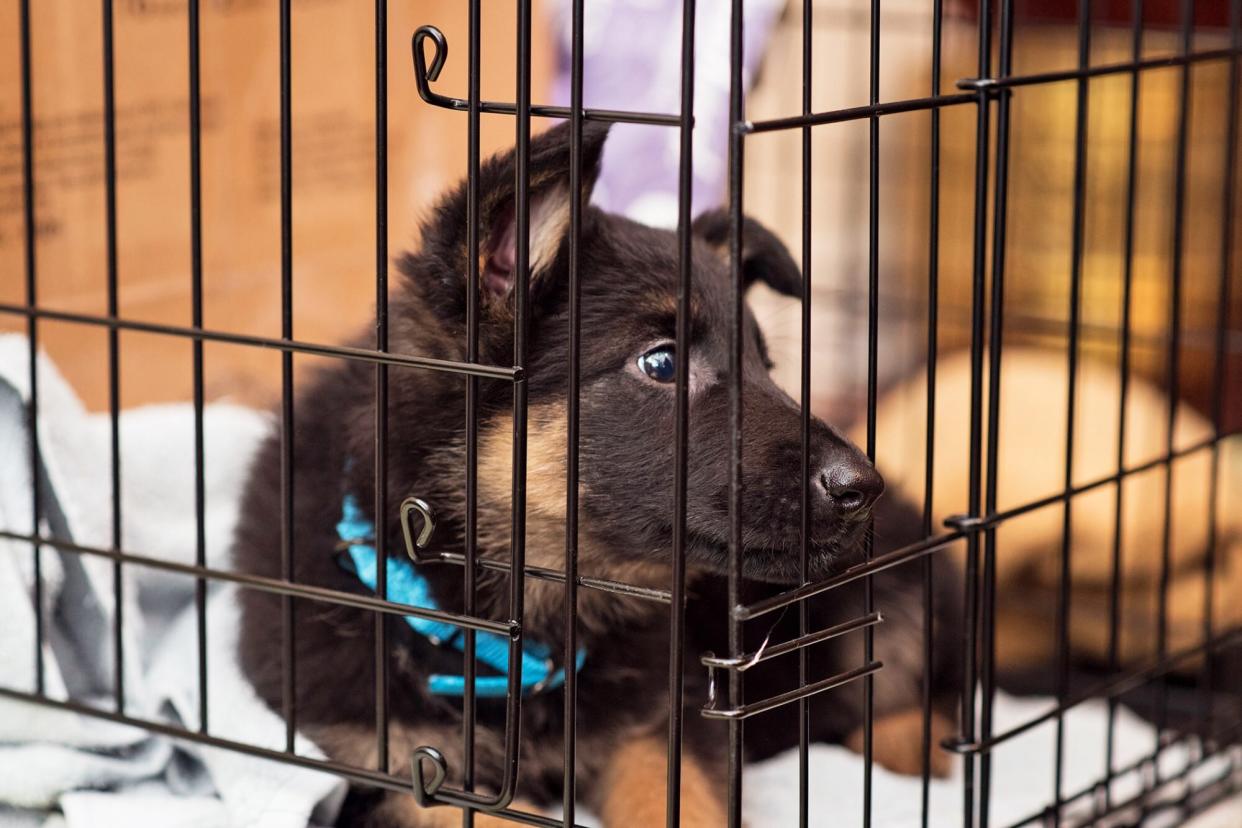How to Crate Train a Puppy at Night (With Minimal Fuss!)

Sharon_Mendonca / Getty
You're doing all the things to crate train your puppy right: feeding meals in there, adding fun toys and cozy bedding, and encouraging your pup to consider it his own space. But now, how do you crate train a puppy at night?
When it comes to going to bed, puppies aren't always the greatest at settling down. Just like babies, they often wake up in the middle of the night. They need to go potty. They're lonely. They miss their littermates. They want to play, snuggle, or have a snack. But don't worry, there are ways to get your pup to stay asleep. We tapped Heather Gillihan, a certified dog trainer with Zoom Room, for secrets on helping your little furball sleep through the night.
RELATED: The Do's and Don'ts of Crate Training a Puppy
Where to Put the Crate
"Put yourself in your puppy's shoes," Gillihan says. "It's scary to go to a new home where you don't have your littermates or mom. So for the first couple of nights, it's your job to help your tiny canine get comfortable in his new surroundings."
Initially, place the puppy-sized crate right next to your bed at the same level as you. Use a sturdy chair, table, or nightstand. If your puppy starts fussing, rest your fingers in the crate through the cage door to reassure him.
Once your puppy gets used to being in his crate at night, you can slowly transition the crate away from you. Start by putting more distance between the bed and the crate. Then move the crate to the floor and finally, to whatever room your pup is going to sleep in permanently. At that point, your puppy has adjusted to family life, Gillihan says.
Create a Bedtime Routine Before Crate Time
Having a bedtime routine is just as important for puppies as it is for people. It helps prevent potty accidents and endless wake-ups in the middle of the night. And it gets your puppy ready to sleep. Here are some things to consider doing before tucking in your pup.
Be Strategic With Food and Water Timing
Feed your puppy dinner at least a few hours before bedtime. That way your puppy has time to process it and do his business before turning in for the night. Also, keep the water in your pup's bowl to a minimum the last hour before his curfew.
RELATED: Must-Dos When Potty Training a Dog
Create a Winding-down Routine
There are differing opinions on what a puppy's bedtime routine should look like. Do you try to wear your puppy out with a play session or walk? Or do you try to calm your puppy down with snuggling and petting?
"What's most important is that you have a routine, not necessarily what's in it," Gillihan says. "It's just a way to signal to the dog that it's time to wind down. With my own dogs, I'll do a relaxing routine. I'll have them settle down with a chew toy and then brush their teeth afterward." Whatever you choose, be consistent. Your dog will come to recognize and expect the nightly routine.
How to Handle Whining and Barking
The biggest problem pet parents have with nighttime crate training is when puppies put up a fuss. Does your puppy really need to go potty or does he just want attention? It can be hard to tell. If it's the middle of the night, assume your puppy has to go potty, Gillihan says. Give your puppy the chance to relieve himself and then put him back in the crate. Use this info as a guideline for how long your puppy can hold it in the crate:
8–10 weeks old: 30–60 minutes
11–14 weeks old: 1–3 hours
15–16 weeks old: 3–4 hours
17+ weeks old: 4–5 hours
RELATED: How Often Do Dogs Need to Pee? A Vet Explains
"What's really important is making sure there's no communication. You take your puppy out, don't talk, maybe say go potty. Then as soon as your puppy is done, he goes back in the crate," she says. "That way you're not providing attention and stimulation. When you talk to your puppy, it's rewarding and encourages him to repeat the crying behavior."
If your puppy continues to bark or whine in the crate after having a potty break, you can give him a little while to see if he settles down. Don't immediately respond or talk or love on your puppy—it'll just reinforce the crying behavior.
To alleviate your puppy's stress at night, consider using a comfort item. Many pet parents swear by specially designed stuffed animals that have warm bodies and heartbeats. They simulate a littermate. You can also try a thunder shirt, which pet parents typically use to soothe canines afraid of thunder. But it also works for puppies, similar to how a swaddle comforts newborns.
RELATED: 10 Dog Crate Ideas That Actually Look Good in Your Home
Be Consistent
Doing the same thing over and over creates habits. So consistency is incredibly important to teach your dog how to fit in with the family. A bedtime routine helps puppies know what's coming and get settled for bed. Using positive reinforcement to crate train your puppy during the day pays off when your pup happily cuddles up in his crate. With a little bit of effort and consistency, you and your puppy will be getting a good night's sleep in no time.

